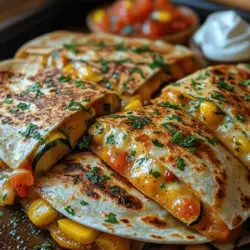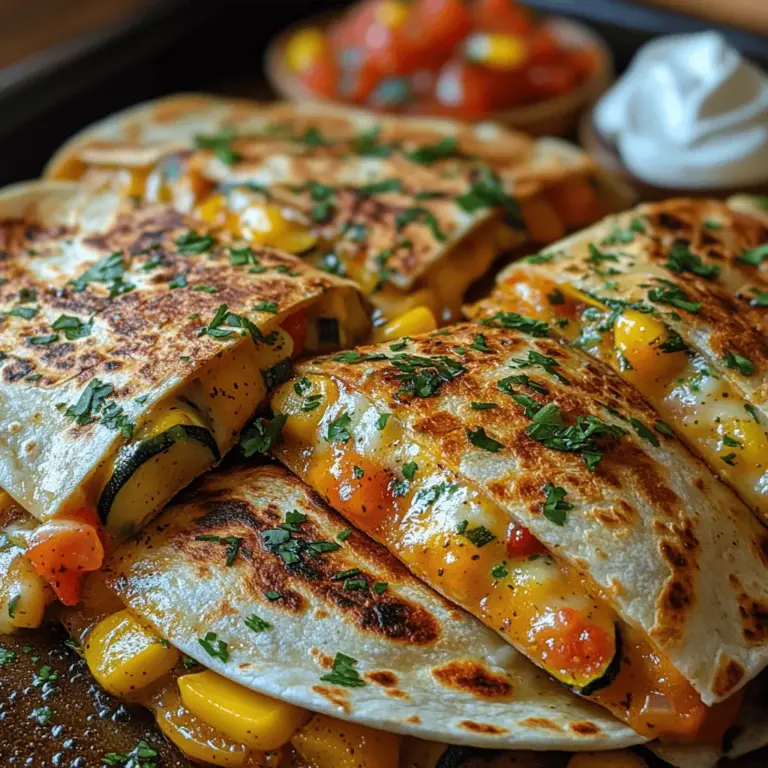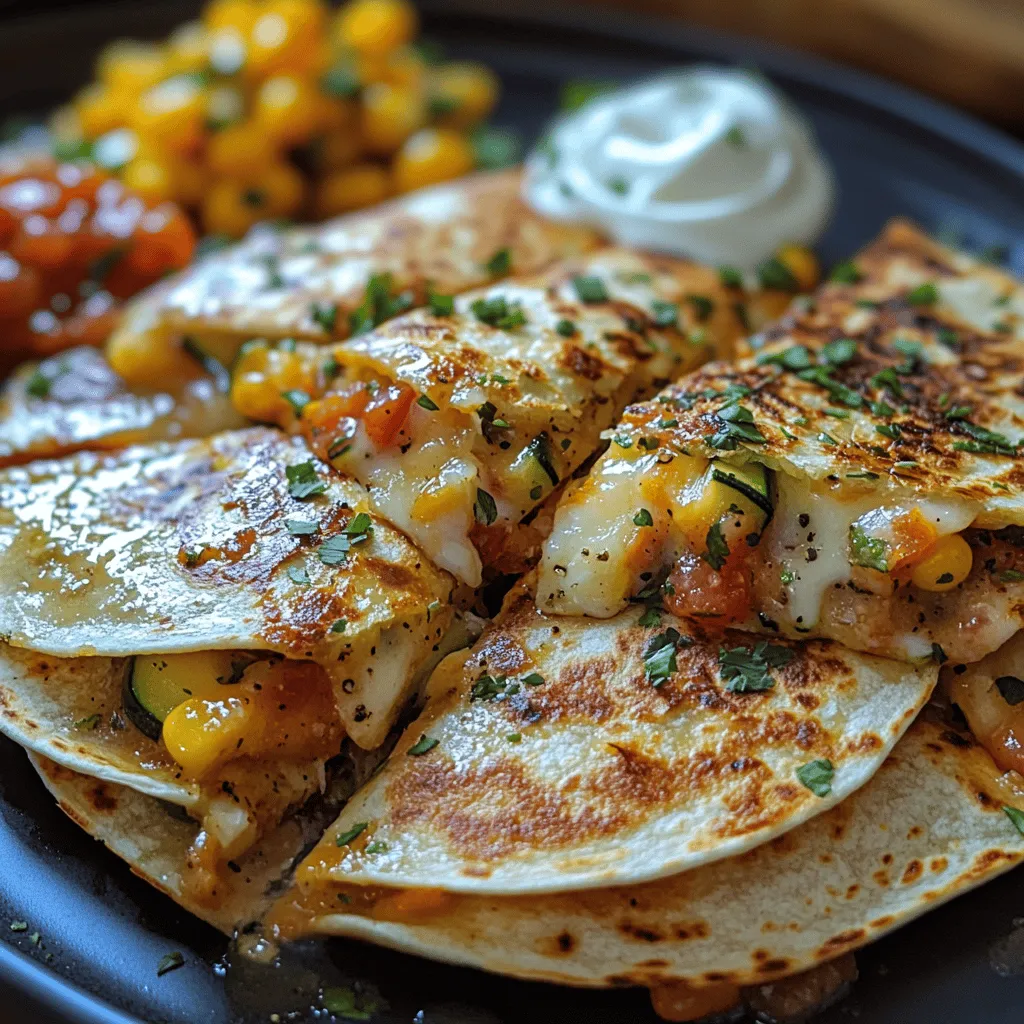As the sun shines brighter and the days lengthen, summer brings a bounty of vibrant vegetables that are perfect for enhancing any dish. The season’s harvest—think zucchini, bell peppers, and sweet corn—offers a palette of flavors and textures that can transform the simplest meals into delightful experiences. One of the most versatile and satisfying ways to showcase these fresh ingredients is through the art of quesadilla-making. The Sizzling Summer Vegetable Quesadillas not only celebrate the season’s produce but also promise an effortless culinary adventure that is as enjoyable to prepare as it is to eat.
Quesadillas, with their crispy tortillas and gooey cheese, serve as the ideal vehicle for incorporating fresh vegetables. Their versatility allows for endless possibilities, making them suitable for a quick lunch, a hearty snack, or even a light dinner. This recipe is particularly appealing for those who want to embrace the flavors of summer while enjoying the convenience of a simple cooking method. The combination of sautéed vegetables enveloped in melted cheese delivers a satisfying crunch and a burst of flavors that truly encapsulate what summer cooking is all about.
Understanding Quesadillas
Definition and History of Quesadillas
Quesadillas are a beloved staple in Mexican cuisine, traditionally made with a tortilla filled with cheese and other ingredients, then folded in half and grilled or toasted until the cheese melts and the tortilla becomes golden brown. The word “quesadilla” comes from the Spanish word “queso,” meaning cheese, which highlights the key ingredient that makes these dishes so delightful. The origins of quesadillas date back to the colonial period in Mexico when tortillas were filled with cheese and other locally available ingredients, leading to the creation of this delicious snack.
Over time, quesadillas have evolved beyond their simple origins, adapting to regional tastes and available ingredients. Today, they can be found in various forms—from the classic cheese-only versions to those loaded with meats, beans, and a plethora of vegetables. This evolution is a testament to the creativity and resourcefulness of cooks who have embraced the quesadilla as a canvas for culinary expression.
Health Benefits of Incorporating Vegetables into Quesadillas
One of the most significant advantages of making vegetable quesadillas is the opportunity to boost nutrition without sacrificing flavor. Incorporating a variety of vegetables not only enhances the taste and texture but also adds an array of health benefits. Vegetables are generally low in calories and high in essential nutrients, making them an excellent choice for those looking to maintain a balanced diet.
By choosing seasonal produce, you can take advantage of the peak freshness and flavor while also supporting local farmers. The Sizzling Summer Vegetable Quesadillas are particularly rich in vitamins, minerals, and dietary fiber, which contribute to overall health and wellness. Including a medley of colorful vegetables ensures a diverse intake of nutrients, supporting everything from immune function to digestive health.
Ingredients Breakdown
To create the perfect Sizzling Summer Vegetable Quesadillas, you’ll need a selection of fresh vegetables, flavorful seasonings, and delicious cheeses. Here’s a closer look at the primary ingredients that make this dish a standout:
Zucchini
Zucchini is a summer squash that is often celebrated for its versatility. It has a mild flavor and can be easily incorporated into various dishes. Nutritionally, zucchini is low in calories and boasts a high water content, making it an excellent choice for staying hydrated during the warmer months. It is also a source of vitamin C, which supports immune health and skin vitality.
Yellow Squash
Similar to zucchini, yellow squash is another summer favorite. It is packed with vitamins A and C, both of which are crucial for maintaining healthy skin and eyesight. Yellow squash adds a lovely color and slightly sweet flavor to the quesadillas, making each bite a delightful experience.
Red Bell Pepper
Red bell peppers are not only visually appealing but also incredibly nutritious. They are rich in antioxidants, particularly vitamin C, which is known for its immune-boosting properties. Additionally, red bell peppers contribute a sweet and slightly tangy flavor to the quesadillas, enhancing the overall taste profile.
Corn
Sweet corn is a quintessential summer ingredient that brings a natural sweetness and crunch to dishes. It is a good source of fiber, which aids in digestion, and contains essential minerals such as magnesium and potassium. The addition of corn to the quesadillas creates a delightful contrast in texture, making each bite satisfying.
Red Onion
Red onions are often overlooked but are packed with flavor and health benefits. They contain anti-inflammatory properties and antioxidants that support overall health. When sautéed, red onions become sweet and tender, adding depth to the quesadilla filling.
Cheese Selection
The choice of cheese can make or break a quesadilla. For this recipe, a combination of mozzarella and cheddar is recommended. Mozzarella melts beautifully, creating that irresistible gooey texture, while cheddar adds a sharpness and depth of flavor. Together, they create a creamy, rich filling that perfectly complements the fresh vegetables.
Preparation of Sizzling Summer Vegetable Quesadillas
Now that you have a clear understanding of the ingredients and their benefits, it’s time to dive into the preparation of these delicious Sizzling Summer Vegetable Quesadillas. Follow these steps to ensure that your quesadillas are bursting with flavor and perfectly cooked.
Step 1: Prepare the Vegetables
The first step in creating your Sizzling Summer Vegetable Quesadillas is to prepare your vegetables. Start by washing all of your produce thoroughly. For the zucchini and yellow squash, slice them into thin rounds, about 1/4 inch thick. Thinly sliced vegetables will cook more evenly and quickly, ensuring that they retain their texture and vibrant colors.
Next, chop the red bell pepper into bite-sized pieces and slice the red onion into thin strips. The goal is to have a uniform size across all the vegetables to promote even cooking.
Step 2: Season the Vegetables
Once your vegetables are prepped, it’s time to season them. In a large mixing bowl, combine the sliced zucchini, yellow squash, red bell pepper, corn, and red onion. Drizzle with olive oil and sprinkle in garlic powder, cumin, salt, and pepper to taste. Olive oil not only adds flavor but also helps to prevent sticking during cooking. Garlic powder and cumin introduce a warm, aromatic quality that elevates the dish, while salt and pepper enhance the natural flavors of the vegetables.
Step 3: Sauté the Vegetables
Heat a large skillet over medium heat and add a splash of olive oil. Once hot, add the seasoned vegetables to the skillet. Sauté them for about 5-7 minutes, stirring occasionally, until they are tender and slightly caramelized. The goal is to achieve a lovely golden-brown color on the vegetables while ensuring they remain crisp and flavorful.
As the vegetables cook, the aromas will begin to fill your kitchen, setting the stage for the delicious quesadillas that are about to come together. Once the vegetables are cooked, remove them from the heat and set them aside to cool slightly before assembling the quesadillas.
By following these initial steps, you’re well on your way to creating a delicious and satisfying dish that showcases the best of summer’s produce. The next part of the recipe will guide you through the assembly and cooking process, ensuring that you achieve the perfect crispy, cheesy quesadilla. So, stay tuned for the continuation of this flavorful journey!
Optimal Cooking Techniques for Achieving Tenderness and Caramelization
Cooking the vegetables to perfection is essential for creating Sizzling Summer Vegetable Quesadillas. To achieve tenderness and bring out the natural sweetness of the vegetables, consider these techniques:
1. Sautéing: Use a medium-high heat to sauté your vegetables. This method allows for quick cooking while retaining their vibrant colors and essential nutrients. Start with denser vegetables like bell peppers and onions, as they take longer to cook, followed by softer vegetables like zucchini and corn.
2. Caramelization: For maximum flavor, allow your vegetables to caramelize slightly. This can be achieved by letting them cook undisturbed for a few minutes before stirring. The natural sugars in the vegetables will brown, enhancing their sweetness and creating a satisfying depth of flavor.
3. Seasoning: Season the vegetables with salt and pepper as they cook. This not only enhances their natural flavors but also helps draw out moisture, allowing for better caramelization. You can also add spices like cumin or paprika for an extra kick.
Tips for Checking Doneness and Flavor Development
To ensure your vegetables are cooked to perfection, follow these guidelines:
– Visual Cues: Look for a vibrant color and a slightly softened texture. Vegetables should be bright and tender but not mushy.
– Taste Tests: Don’t hesitate to taste your vegetables as they cook. This is the best way to check for seasoning and doneness. If they still taste raw or lack flavor, give them a few more minutes in the pan.
– Aroma: The smell of caramelized vegetables is often an indicator of their readiness. If you start smelling a sweet, roasted aroma, it’s a good sign that they are nearing completion.
Assembling the Quesadillas
When it comes to assembling your quesadillas, the right technique and ingredient selection are paramount.
Tips for Tortilla Selection: Flour vs. Corn Tortillas
– Flour Tortillas: These are softer, more pliable, and tend to hold more filling. They are ideal for a quesadilla that is heavily stuffed with ingredients.
– Corn Tortillas: These have a nuttier flavor and are better for a lighter filling. They tend to be crispier but can break if overstuffed.
Choose the tortilla that suits your preference or dietary needs. If gluten-free is your goal, opt for corn tortillas.
Detailed Steps for Layering Ingredients
1. Layering Cheese for Optimal Melt and Binding: Begin by sprinkling a generous layer of shredded cheese directly on the tortilla. Cheese acts as glue, helping to bind the vegetables and ensuring a melty center.
2. Proportioning Vegetables: Avoid overstuffing your quesadilla. A good rule of thumb is to use about 1/2 to 3/4 cup of mixed vegetables per quesadilla, depending on the size of the tortilla. This ensures even cooking and makes flipping easier.
3. Folding Techniques: Once the vegetables and cheese are layered, fold the tortilla in half gently. Use a spatula to press down lightly, which helps the filling settle and encourages the cheese to melt evenly.
Techniques for Cooking Quesadillas
1. Optimal Skillet Temperature: Preheat a non-stick skillet over medium heat. A well-heated skillet will create a golden, crispy exterior while allowing the cheese to melt thoroughly.
2. Cooking Time for Perfect Cheese Melt: Cook each quesadilla for about 3-4 minutes on one side until golden brown, then carefully flip and cook for an additional 2-3 minutes. Keep an eye on the quesadilla; if it browns too quickly, reduce the heat to ensure the cheese melts without burning the tortilla.
Serving Suggestions
Once your Sizzling Summer Vegetable Quesadillas are cooked to perfection, it’s time to serve them up in style.
Creative Ideas for Garnishing
1. Fresh Cilantro: Sprinkle freshly chopped cilantro over the quesadillas for an added burst of flavor and color.
2. Presentation Suggestions: Slice the quesadillas into wedges and arrange them on a platter. This not only makes them easier to serve but also visually appealing.
Complementary Sides
1. Dips: Serve your quesadillas with creamy sour cream and zesty salsa for a delightful contrast. The coolness of the sour cream balances the warmth of the quesadillas, while salsa adds a tangy kick.
2. Other Side Options: Consider pairing with guacamole for a rich, creamy texture or a fresh salad with a citrus vinaigrette to brighten the meal. These sides add freshness and enhance the overall dining experience.
Nutritional Information
Understanding the nutritional content of your meal can help you make informed choices. Here’s a breakdown per serving of the Sizzling Summer Vegetable Quesadillas:
– Calories: Approximately 300-350 calories, depending on the type of tortillas and amount of cheese used.
– Protein: Each serving contains about 12-15 grams of protein, primarily from cheese and vegetables.
– Fiber: Rich in fiber, thanks to the variety of vegetables, each serving provides around 5-7 grams, aiding digestion and promoting fullness.
– Vitamins and Minerals: Packed with essential vitamins from the vegetables, such as vitamin C, potassium, and antioxidants.
A vegetable-rich diet not only supports overall health but also fits seamlessly into a balanced meal plan, offering both flavor and nutrition.
Conclusion
Sizzling Summer Vegetable Quesadillas are a delightful way to enjoy the season’s freshest produce while indulging in a comforting, cheesy treat. With their crispy exterior and gooey, melty center, these quesadillas embody everything you want in a quick meal or snack.
Feel free to experiment with seasonal vegetables and personalize your quesadilla to suit your tastes. Whether you’re hosting a dinner party or looking for a quick weeknight meal, these quesadillas are sure to impress. Enjoy the joy of cooking and sharing delicious, healthy meals with friends and family!


